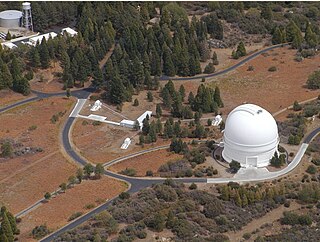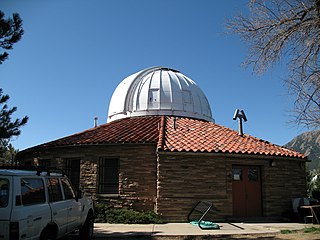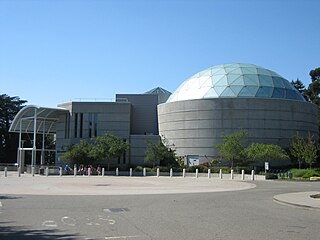
The Kitt Peak National Observatory (KPNO) is a United States astronomical observatory located on Kitt Peak of the Quinlan Mountains in the Arizona-Sonoran Desert on the Tohono Oʼodham Nation, 88 kilometers (55 mi) west-southwest of Tucson, Arizona. With more than twenty optical and two radio telescopes, it is one of the largest gatherings of astronomical instruments in the Earth's northern hemisphere.

El Dorado County, officially the County of El Dorado, is a county located in the U.S. state of California. As of the 2020 census, the population was 191,185. The county seat is Placerville. The county is part of the Sacramento-Roseville-Arden-Arcade, CA Metropolitan Statistical Area. It is located entirely in the Sierra Nevada, from the historic Gold Country in the western foothills to the High Sierra in the east. El Dorado County's population has grown as Greater Sacramento has expanded into the region. Where the county line crosses US 50 at Clarksville, the distance to Sacramento is 15 miles. In the county's high altitude eastern end at Lake Tahoe, environmental awareness and environmental protection initiatives have grown along with the population since the 1960 Winter Olympics, hosted at the former Squaw Valley Ski Resort in neighboring Placer County.

Lowell Observatory is an astronomical observatory in Flagstaff, Arizona, United States. Lowell Observatory was established in 1894, placing it among the oldest observatories in the United States, and was designated a National Historic Landmark in 1965. In 2011, the Observatory was named one of "The World's 100 Most Important Places" by Time Magazine. It was at the Lowell Observatory that the dwarf planet Pluto was discovered in 1930 by Clyde Tombaugh.

Yerkes Observatory is an astronomical observatory located in Williams Bay, Wisconsin, United States. The observatory was operated by the University of Chicago Department of Astronomy and Astrophysics from its founding in 1897 until 2018. Ownership was transferred to the non-profit Yerkes Future Foundation (YFF) in May 2020, which began millions of dollars of restoration and renovation of the historic building and grounds. Yerkes re-opened for public tours and programming in May, 2022. The April, 2024 issue of National Geographic magazine featured a story about the Observatory and ongoing work to restore it to relevance for astronomy, public science engagement and exploring big ideas through art, science, culture and landscape. The observatory offers tickets to programs and tours on its website.

Palomar Observatory is an astronomical research observatory in the Palomar Mountains of San Diego County, California, United States. It is owned and operated by the California Institute of Technology (Caltech). Research time at the observatory is granted to Caltech and its research partners, which include the Jet Propulsion Laboratory (JPL), Yale University, and the National Astronomical Observatories of China.

The Hale Telescope is a 200-inch (5.1 m), f/3.3 reflecting telescope at the Palomar Observatory in San Diego County, California, US, named after astronomer George Ellery Hale. With funding from the Rockefeller Foundation in 1928, he orchestrated the planning, design, and construction of the observatory, but with the project ending up taking 20 years he did not live to see its commissioning. The Hale was groundbreaking for its time, with double the diameter of the second-largest telescope, and pioneered many new technologies in telescope mount design and in the design and fabrication of its large aluminum coated "honeycomb" low thermal expansion Pyrex mirror. It was completed in 1949 and is still in active use.

The Arcetri Observatory is an astrophysical observatory located in the hilly area of Arcetri on the outskirts of Florence, Italy. It is located close to Villa Il Gioiello, the residence of Galileo Galilei from 1631 to 1642.

Mount Laguna Observatory (MLO) is an astronomical observatory owned and operated by San Diego State University (SDSU). The telescope was operated in partnership with the University of Illinois at Urbana-Champaign (UIUC) until 2000. MLO is located approximately 75 kilometers (47 mi) east of downtown San Diego, California (USA) on the eastern edge of the Cleveland National Forest in the Laguna Mountains on the SDSU Astronomy Campus near the hamlet of Mount Laguna. MLO was dedicated on June 19, 1968, seven years after SDSU's Department of Astronomy became an independent academic department of SDSU's College of Sciences. The dedication took place during the 1968 summer meeting of the Astronomical Society of the Pacific. Currently SDSU is working with University of Kansas (KU), and UNC Chapel Hill on various projects. MLO also engages with the public through a series of scientific outreach efforts such as the summer visitors program (SVP). SVP's take place on select dates throughout the summer months and include scientific demonstrations in the museum / gift shop, an introductory lecture on astronomy, and a stargazing session using a myriad of telescopes such as the 0.52 m Reginald Buller 21-inch Visitors' Telescope. The SVP is predominantly run by graduate students within the SDSU Astronomy Master's program.

Sommers–Bausch Observatory is an astronomical observatory located on and owned by University of Colorado Boulder. The building was initially completed in 1953 and named after Elmer E. Sommers and Carl L. Bausch.

Fremont Peak Observatory (FPOA) is an astronomical observatory operated by Fremont Peak Observatory Association (FPOA) under contract to the State of California. Built in 1986, it is located in Fremont Peak State Park, near San Juan Bautista, California. Fremont Peak Observatory houses the Challenger telescope.

Chabot Space and Science Center, located in Oakland, California, is a center for learning in Earth and space science, which features interactive exhibits, planetariums, a large screen theater, hands-on activities, and three powerful telescopes.

The Coudé Auxiliary Telescope (CAT) is a coudé focus telescope located at the Lick Observatory near San Jose, California, south of Shane Dome, Tycho Brahe Peak.
Rescue, formerly Green Valley, El Dorado County, California, is an unincorporated community in El Dorado County, California. It is located north-northwest of Shingle Springs and north-northeast of Cameron Park. The zip code is 95672, and Rescue is located in area code 530. The town lies at an elevation of 1214 feet.

The Northumberland Astronomical Society was founded in 2000 by local amateur astronomers in Northumberland, UK. The society is informally known among its members as "NASTRO". The first formal meetings of the society were held in the village hall at Low Hauxley but increasing membership and the support of the Northumberland Wildlife Trust saw meetings move to the visitor centre in the nearby Hauxley Nature Reserve in 2002. The Nature Reserve was burned down in an arson attack on 29 June 2010, so society meetings are now held in the Beehive function room at The Trap Inn until the new building is completed, which is expected to be in 2017.

The Eileen M. Collins Observatory is a small astronomical observatory operated by Corning Community College in Corning, New York, United States. It is named for astronaut Eileen Collins. The observatory is primarily used to teach astronomy classes, but the college also provides monthly viewing sessions for the public.
The Dark Sky Observatory (DSO) is an astronomical observatory owned and operated by Appalachian State University (ASU). It is located 9 kilometers (5.6 mi) east of Deep Gap, North Carolina (USA), off of the Blue Ridge Parkway, and 32 kilometers (20 mi) east of the ASU campus in Boone, North Carolina It was established in 1981, and is used for research, instruction, and public viewing events. The Cline Visitors' Center was completed in 2011.

Bayfordbury Observatory is the University of Hertfordshire's astronomical and atmospheric physics remote sensing observatory, and one of the largest teaching observatories in the UK. It is located in the relatively dark countryside of Bayfordbury, Hertfordshire, 6 miles from the main university campus in Hatfield. The first telescope was built in 1969, and since then has been used as a teaching observatory for undergraduate students, staff and student research as well as for public outreach activities.
The Adolphson Astronomical Observatory, located atop the Center for Science and Business in Monmouth, Illinois, U.S., on the campus of Monmouth College, was built in 2013. Its largest telescope is the 20-inch reflecting Trubeck Telescope. The observatory is used for undergraduate student education, undergraduate research including the tracking and discovery of near-earth objects, and for public awareness of science.

The Hampstead Scientific Society (HSS) in north London was founded in July 1899 as the Hampstead Astronomical and General Scientific Society by P.E. Vizard. It aims to be inclusive, promoting and nurturing an interest in all branches of science, while catering for wide levels of knowledge, from layman to expert alike. The society maintains specialist astronomy and meteorology sections and runs a programme of lectures on various scientific topics in the Hampstead area of North West London.
Mount Kent Observatory near Toowoomba, in the Darling Downs region of Queensland, Australia, is an observatory owned and operated by the University of Southern Queensland (USQ). It is the only professional astronomical research observatory in the state of Queensland. Mount Kent hosts the four MINERVA-Australis exoplanet-finding telescopes, three SONG telescopes for asteroseismology and stellar astrophysics, two 'Shared Skies' telescopes, and a USQ-Louisville telescope.
















